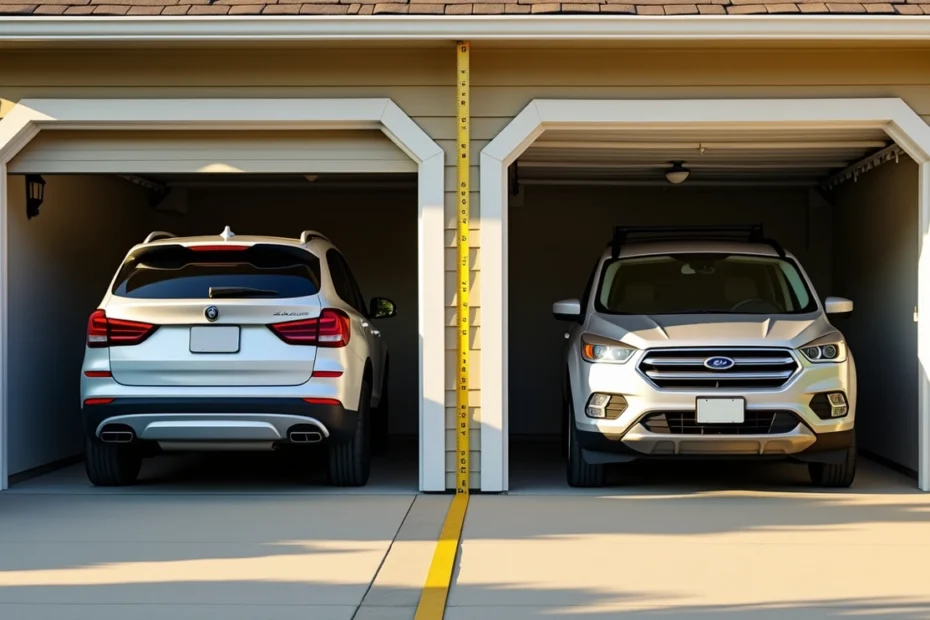Garage door widths vary more than most people expect, despite common beliefs about “standard” sizes. Most homeowners are surprised when they learn that “standard” garage door sizes come in multiple variations. Picking the wrong dimensions can lead to daily frustration, despite many assuming a one-size-fits-all approach.
A door that’s too small creates parking challenges, but an oversized one may not be compatible with your garage’s structure. Common garage door widths for single-car entrances typically span 8 to 9 feet wide by 7 to 8 feet high. Your vehicle’s size determines your specific needs. Truck owners should think about going with larger dimensions. Double-car garage doors measure about 16 feet wide by 7 to 8 feet high. The builder’s preferences and regional differences can affect typical garage door sizes. Getting these garage door dimensions right is significant before making any decisions.
Let’s explore why homeowners often miscalculate their garage door needs. We’ll break down the actual standard sizes for different situations and give you practical guidance to find the perfect fit for your home and vehicles.
Why Garage Door Widths Are Often Misjudged
Homeowners often make pricey mistakes with garage door widths because they don’t understand how garages and vehicles can vary. A wrong size choice turns simple parking into a daily headache.
Assuming all garages are built to standard
Most people think garage doors follow universal standards. They care more about style and color than getting the right size. Each garage has its own unique requirements, which makes professional measuring crucial for the right fit. Even existing garages might need custom-sized doors instead of standard ones. What fits perfectly at one house might not work at all for another, whatever they look like.
Overlooking vehicle size and clearance needs
Your vehicle’s size substantially affects the garage door width you need. A compact car needs about 6 feet of width, while full-size trucks and SUVs can be up to 7 feet wide. Experts say you should add 2-5 feet of space around your vehicle to move around comfortably.
Here’s what works best:
- Compact cars: At least 8-foot door width
- SUVs/Crossovers: 9 or 10-foot door width
- Full-size trucks: 10 to 12-foot door width
People who pick door widths without measuring their biggest vehicle end up with tight fits, door dings, and daily parking hassles. This mistake makes parking tough and could damage both your car and the garage structure.
Ignoring future vehicle or storage plans
The biggest mistake happens when people don’t think about their future needs. They pick garage door widths based on their current cars without planning. A wider door now saves you from expensive changes later.
On top of that, garages do more than just house cars. You’ll run out of space quickly without room for shelves, workbenches, or storing recreational equipment. Even with just one car, experts suggest wider doors if you plan to use your garage as a storage or working area.
Smart homeowners look ahead 5-10 years and think about bigger vehicles, extra storage needs, or workshop space.
Understanding Standard Garage Door Widths

Garage door sizes can vary a lot based on what you need them for. Here’s a detailed look at the measurements for different garage door types to help you pick the right one.
Single-car garage door widths
You’ll find single-car garage doors in three main sizes. Each size fits different vehicles and space requirements:
- 8 feet wide by 7 feet high – Older homes often have this size. It works for compact cars, but larger vehicles might feel cramped
- 9 feet wide by 7 feet high – This wider option gives you better clearance, and new homes tend to have these
- 10 feet wide by 7-8 feet high – Perfect if you own a larger sedan or small SUV and need extra space to move around
The 9-foot width has become popular with homeowners because that extra foot makes parking and unloading much easier.
Double-car garage door widths
Double garage doors fit two vehicles side by side. These doors come in standard sizes:
The most common size is 16 feet wide by 7 feet high. You can find widths from 12 to 20 feet, depending on your garage design and needs. An 18-foot width works great for bigger vehicles since it leaves more space between cars and helps prevent door dings.
RV and specialty garage door dimensions
RV garages need much bigger openings because recreational vehicles are larger:
Your RV door should be at least 10-12 feet wide. Height plays a crucial role, too – these doors usually range from 12 to 16 feet tall. Class A motorhomes need a minimum 10-foot width, but 12 feet makes getting in and out much easier. Any residential garage door taller than 8 feet needs commercial-grade hardware to stay structurally sound.
Commercial garage door widths
Commercial buildings need larger doors to fit trucks and equipment:
Standard overhead doors in commercial spaces measure 32 feet by 2 inches wide and 24 feet by 1 inch tall. Roll-up doors are usually 30 feet by 4 inches wide and 28 feet by 4 inches high. Climate-controlled spaces use insulated doors that measure 30 feet by 2 inches wide and 24 feet by 1 inch high.
These standard sizes give you a good starting point, but you can always get custom sizes if you have special needs or vehicles.
Common Measurement Mistakes Homeowners Make
Proper measurements are the foundations of a successful garage door installation. Small measurement errors can cause major functionality issues and costly repairs.
Measuring only the opening, not the frame
Many homeowners make the mistake of measuring just the door opening width and miss vital frame dimensions. Your garage door measurement should include both the finished frame opening and rough opening measurements. A standard 9×7 garage door needs a rough opening of 9 feet 9 inches wide by 7 feet 3 inches tall. You should measure from multiple points along the opening because walls may not be perfectly straight.
Forgetting headroom and side clearance
Width and height measurements are just the start. You also need to consider headroom (space above the door) and side room requirements. Torsion-spring hardware needs 12 inches of headroom clearance. Doors with electric openers need an extra 2 inches added to standard lift operations. The garage door’s sides each require about 4-5 inches for vertical track installation.
Not accounting for garage door tracks and openers
Your garage door needs enough backroom—the distance from the opening to the back wall. Manual lift doors need the door height plus 18 inches of backroom. Electric opener installations require door height plus 4’2″. Standard residential 2-inch vertical track needs a minimum side room of 4 inches.
Relying on outdated or incorrect blueprints
Old blueprints often fail to meet modern garage door requirements. Check for potential issues before installation. Look for uneven floors, pipes, ductwork, or electrical obstacles that could affect operation. Watch out for ceiling-mounted obstacles that might change your headroom calculations.
How to Choose the Right Garage Door Width

Picking the right garage door width requires more than just taking measurements. This choice will affect your daily life and property value for many years.
Match door size to current and future vehicle needs
Your vehicle’s size should be the main goal when picking a garage door width. An 8-foot-wide door might be enough for compact cars. Larger vehicles like SUVs, trucks, and minivans need at least a 9 or 10-foot-wide single door. Think beyond today’s needs. You might want to upgrade from your sedan to a larger SUV or truck later. Experts suggest leaving 1-2 feet of clearance on each side of your vehicle for easy access.
Think over the garage layout and storage use
Your garage does more than just park cars. The door width should match your plans to store tools, sports equipment, or seasonal items. Wall shelving, utility racks, or side entrances take up space and reduce usable width. Garages that double as workshops or home gyms work better with wider doors. This extra space helps move large items easily.
Use professional measurement services
Professional measuring is vital for a proper fit and smooth installation. Experts take precise measurements of:
- Width of the garage door opening
- Height from floor to top of opening
- Side room (minimum 3.75 inches required for tracks)
- Headroom (10-12 inches minimum for standard openers)
- Backroom (door height plus 18 inches minimum)
Custom doors for better fit and function
Older homes or custom-built garages often need custom garage doors. These doors work great for oversized vehicles, RVs, lifted trucks, or specialized equipment. Custom doors cost more but end up offering better convenience, accessibility, and long-term value.
Conclusion
Many homeowners overlook garage door width during home planning. The right size makes a huge difference between easy parking and daily frustration. Most people assume standard sizes work for everyone, but this assumption no longer holds true.
Your vehicle’s dimensions should guide your choice. An 8-foot opening works well for compact cars, while trucks and SUVs just need 9-10 feet of clearance. It also helps to plan for future vehicle upgrades or extra storage space.
Precise measurements help avoid making pricey mistakes. Professional consultation before installation saves time and money. Experts check significant factors like headroom, side clearance, and track requirements that DIY measurements might miss.
Standard sizes fit most homes, but custom options work well for unique layouts. You won’t have to compromise on functionality or accessibility if your garage has non-standard dimensions.
Garage door width might seem trivial during construction or renovation, but this choice affects your daily routine for years. A wise decision now prevents future problems and boosts your home’s value and lifestyle quality. The perfect garage door changes a simple necessity into a genuine convenience that you’ll value every time you return home after a long day.
